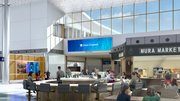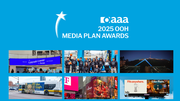Content
Deel Media chief shares digital signage tips, best practices
Bill Clapes, president and CEO of Deel Media, shares expert insight on digital strategy, missteps and how best to leverage digital signage in the theme park environment.

September 3, 2025 by Judy Mottl — Editor, RetailCustomerExperience.com & DigitalSignageToday.com
There are few digital signage professionals whose Internet and technology experience goes beyond three decades.
Bill Clapes, president and CEO of Deel Media, is one.
In the 1990s he pioneered internet tech in the restaurant industry and was deemed an "Innovator of the Year" in 1996 by a leading internet-based news site.
In 2009 he co founded Deel Media, which marked the culmination of years in media, audio visual, interactive and internet technology. In his role as president and CEO he leads the company's blueprint for growth and partnerships.
Deel Media offers the Carbon platform allows can provide virtually any solution for a wide range of verticals, from retail to QSR to theaters and convenience stores.
Clapes now boasts 15 years of providing end-to-end digital signage solutions and Deel Media is well known for its digital menu board design and content management expertise.
Members of Deel's creative team design customer-facing content for Regal Cinemas, Pizza Hut, Universal Studios Theme Parks and many others for over a decade. The company services over 425 Regal and Cineworld theaters in the U.S. and U.K. and, in 2011, began implementing digital food and merchandising for Pilot's Flying J Fresh Marketplace stores. As of 2020 Deel Media was servicing 520 Pilot Travel Center locations.
Its Carbon content management software platform is used exclusively by Universal Studios Theme Parks in Orlando and Hollywood to manage restaurant and kiosk digital menu boards throughout the parks.
In addition, the company has partnered with luxury retailers, including Neiman Marcus, to design and build a touch-screen interactive fashion-retail store directory system. Deel Media also developed an interactive kiosk for use in LG's customer center in Best Buy that pairs with dynamic API feeds and user authentication to expand the shopping experience
DigitalSignageToday.com reached out to Clapes, via an email interview, to gain insight on digital signage trends, technology innovations and tips on deploying digital signage in the theme park environment.
Q. What should a brand or organization know beforehand when embarking on a digital signage strategy – is there anything they need to do internally (i.e. set up a project team)?
Clapes: Implementing a digital signage network is a multi-disciplined project, which includes an executive sponsor who will pave the way and cut through any individual departmental objections that may arise.
The team should also include several teams, including:
- IT: a network will be required.
- Accounting: which will ensure smooth processing of POs and payments.
- Facilities: for electrical, wall blocking, patching and paint.
- Merchandising department: this is the team whose strategy will be implemented.
- Warehousing: who will receive and store the hardware.
- Creative: who will be responsible for executing the strategy.
Depending upon the organization, you may also find other departments that should be included. It's best to include all internal stakeholders in the decision-making process as all will have a hand in ensuring project success.
Q. What are some of the common missteps that are made with digital signage?
Clapes: There have been a few common missteps, and some of the ones that I have seen are focused around physical and creative execution:
Regarding physical execution, messaging displayed on screen hung on a wall in landscape orientation (like in a family room) connotes entertainment; think sports bar. People may not even notice the content, even if it's motion content, because of the orientation. However, screens installed in portrait orientation (like a poster) are subconsciously thought to be messaging information, and due to the less common form, are much more likely to be noticed. Multi-screen arrays with unusual shapes are also very effective at capturing attention.
Regarding creative execution, many companies approach digital without a clear communication strategy. Instead, they simply display digital versions of their static signage 24/7. That's certainly more efficient than having to print signs every time a price changes, but it fails to take advantage of the power that digital offers. A dynamic digital content management system allows companies to message by day of week, daypart and location in the park.
Understanding the visitation demographics and messaging to customer's interest will sell more products, and generate more revenue. Using the right amount of motion to capture attention and highlight the call-to-action is key in a busy theme park environment.
Q. When the project site is a theme park or large event venue what do owners/companies need to take into consideration — what approach or strategy works best?
Clapes: We always plan to complete installation work after park hours. Theme parks offer a magical experience that takes people outside of their normal day-to-day. But seeing an installation crew with hard hats in the middle of the park would snap a visitor out of that enchanted environment and right back into "real life" which is what we try to avoid.
Q. Are there any misconceptions among theme parks/big venues when it comes to digital signage?
Clapes: There are companies who have a misunderstanding of how to leverage the investment in digital signage into increased revenue. This is because it requires a deep understanding of customer visitation patterns and consistent effort to focus messaging towards visitors who are in the park at any given time. The more relevant you can make an offer, the more likely it is that consumers will act upon that offer.
Q. When it comes to deciding content management of signage what should clients consider in deciding whether to do in house or have a partner manage the content?
Clapes: Small venues with a few screens, and little in the way of content or price change requirements, may be best off with manual content management: using content on a thumb drive to update their messaging. However, as the number of screens grows within a venue, and the number of venues grows, the requirement for a centrally managed content management platform (like Deel's Carbon) becomes evident.
At Deel, we have had great success with customers who handle all of the creative and content management themselves. But we also work with customers on a hybrid approach, where we share the creative and content management duties, and have other customers who fully outsource creative and content management to us. It really depends on the resources that a company has in-house, and the priorities of the department on whom the responsibility falls.
Q. What tips or advice do you have for theme parks and large venue operators considering digital signage?
Clapes: It's best to have a clear reason for converting static signage to digital. There are many great reasons for converting, including faster time-to-market for new content and promotions, a more compelling customer experience and operations efficiencies. But we always recommend understanding in advance how these benefits will impact the business. Make sure to leverage the investment in digital to increase revenue, measure the impact and adjust as needed. Finally, choose an experienced provider who can help you along the journey and provide advice that will lead to ongoing success.
About Judy Mottl
Included In This Story
DEEL Media
DEEL is a prominent player in the digital signage industry with 15 years of providing end-to-end signage solutions. We are renowned for our expertise in digital menu board design and management. Our dedication to innovation and client success solidifies our position as the preferred partner for enterprises seeking Digital Signage Excellence.








